Analysis: Home Health Care Impact on COPD Readmission Rates Review
VerifiedAdded on 2023/06/10
|6
|1607
|264
Literature Review
AI Summary
This paper reviews the impact of home-based healthcare on readmission rates for patients with Chronic Obstructive Pulmonary Disease (COPD). It analyzes multiple research articles, comparing their research questions, sample populations, and limitations. The review highlights that transitional care activities and home-based care significantly decrease hospital readmissions post-discharge, improve the quality of care, and enhance patient safety, especially for high-risk individuals. Effective interventions include patient education, needs assessment, medication reconciliation, follow-up calls, and outpatient appointments. The paper concludes that enhanced communication, advanced care planning, and healthcare professional training are crucial for managing conditions that commonly lead to hospital readmissions.
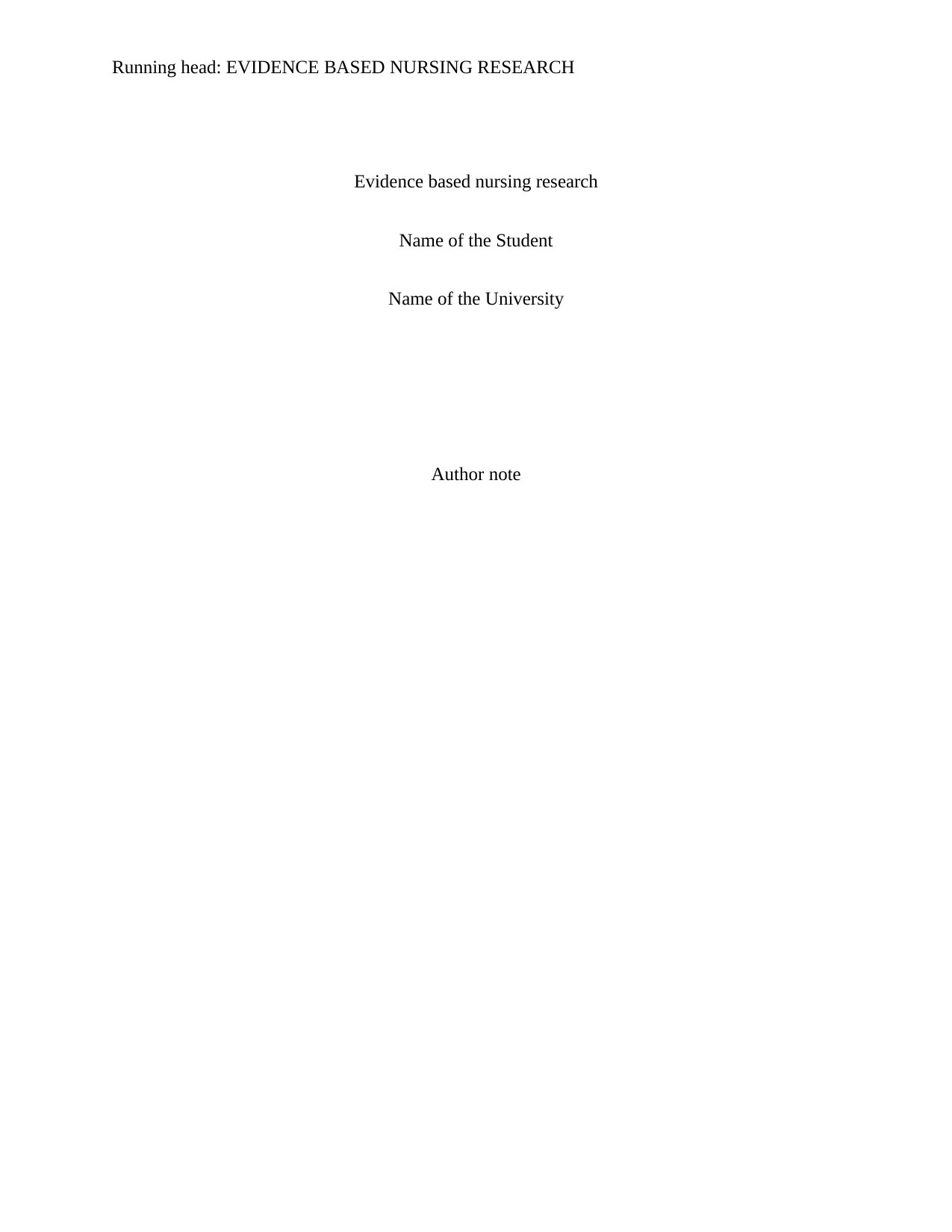
Running head: EVIDENCE BASED NURSING RESEARCH
Evidence based nursing research
Name of the Student
Name of the University
Author note
Evidence based nursing research
Name of the Student
Name of the University
Author note
Paraphrase This Document
Need a fresh take? Get an instant paraphrase of this document with our AI Paraphraser
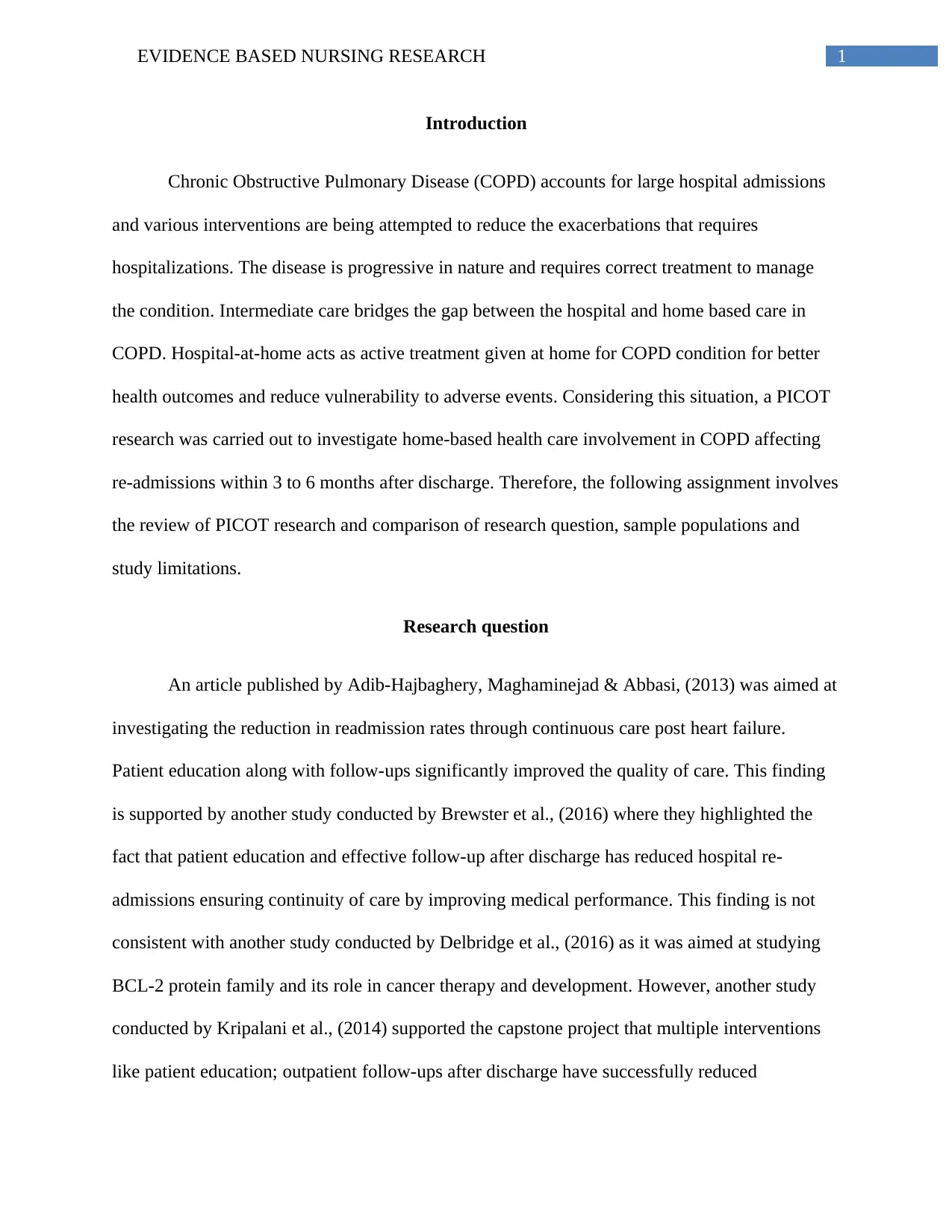
1EVIDENCE BASED NURSING RESEARCH
Introduction
Chronic Obstructive Pulmonary Disease (COPD) accounts for large hospital admissions
and various interventions are being attempted to reduce the exacerbations that requires
hospitalizations. The disease is progressive in nature and requires correct treatment to manage
the condition. Intermediate care bridges the gap between the hospital and home based care in
COPD. Hospital-at-home acts as active treatment given at home for COPD condition for better
health outcomes and reduce vulnerability to adverse events. Considering this situation, a PICOT
research was carried out to investigate home-based health care involvement in COPD affecting
re-admissions within 3 to 6 months after discharge. Therefore, the following assignment involves
the review of PICOT research and comparison of research question, sample populations and
study limitations.
Research question
An article published by Adib-Hajbaghery, Maghaminejad & Abbasi, (2013) was aimed at
investigating the reduction in readmission rates through continuous care post heart failure.
Patient education along with follow-ups significantly improved the quality of care. This finding
is supported by another study conducted by Brewster et al., (2016) where they highlighted the
fact that patient education and effective follow-up after discharge has reduced hospital re-
admissions ensuring continuity of care by improving medical performance. This finding is not
consistent with another study conducted by Delbridge et al., (2016) as it was aimed at studying
BCL-2 protein family and its role in cancer therapy and development. However, another study
conducted by Kripalani et al., (2014) supported the capstone project that multiple interventions
like patient education; outpatient follow-ups after discharge have successfully reduced
Introduction
Chronic Obstructive Pulmonary Disease (COPD) accounts for large hospital admissions
and various interventions are being attempted to reduce the exacerbations that requires
hospitalizations. The disease is progressive in nature and requires correct treatment to manage
the condition. Intermediate care bridges the gap between the hospital and home based care in
COPD. Hospital-at-home acts as active treatment given at home for COPD condition for better
health outcomes and reduce vulnerability to adverse events. Considering this situation, a PICOT
research was carried out to investigate home-based health care involvement in COPD affecting
re-admissions within 3 to 6 months after discharge. Therefore, the following assignment involves
the review of PICOT research and comparison of research question, sample populations and
study limitations.
Research question
An article published by Adib-Hajbaghery, Maghaminejad & Abbasi, (2013) was aimed at
investigating the reduction in readmission rates through continuous care post heart failure.
Patient education along with follow-ups significantly improved the quality of care. This finding
is supported by another study conducted by Brewster et al., (2016) where they highlighted the
fact that patient education and effective follow-up after discharge has reduced hospital re-
admissions ensuring continuity of care by improving medical performance. This finding is not
consistent with another study conducted by Delbridge et al., (2016) as it was aimed at studying
BCL-2 protein family and its role in cancer therapy and development. However, another study
conducted by Kripalani et al., (2014) supported the capstone project that multiple interventions
like patient education; outpatient follow-ups after discharge have successfully reduced
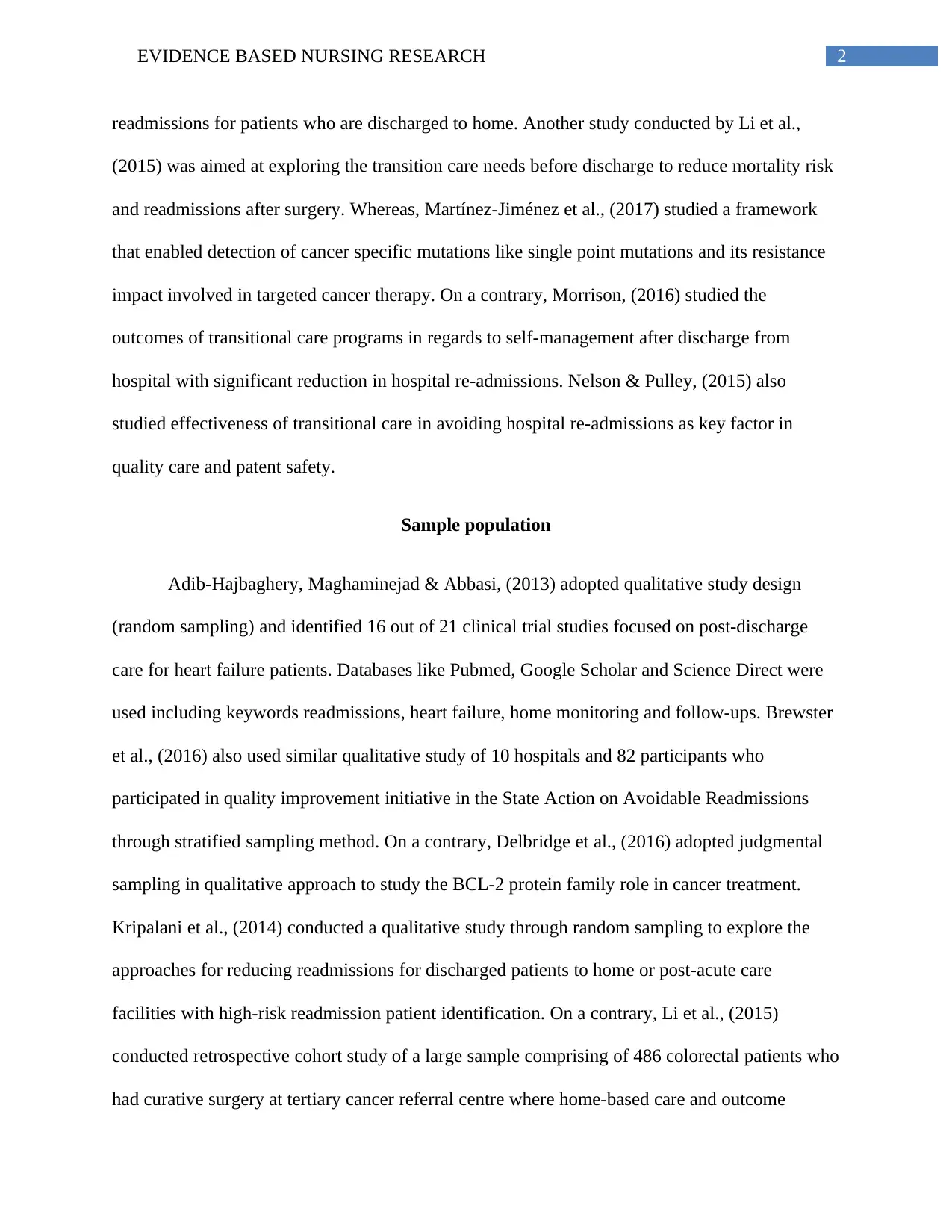
2EVIDENCE BASED NURSING RESEARCH
readmissions for patients who are discharged to home. Another study conducted by Li et al.,
(2015) was aimed at exploring the transition care needs before discharge to reduce mortality risk
and readmissions after surgery. Whereas, Martínez-Jiménez et al., (2017) studied a framework
that enabled detection of cancer specific mutations like single point mutations and its resistance
impact involved in targeted cancer therapy. On a contrary, Morrison, (2016) studied the
outcomes of transitional care programs in regards to self-management after discharge from
hospital with significant reduction in hospital re-admissions. Nelson & Pulley, (2015) also
studied effectiveness of transitional care in avoiding hospital re-admissions as key factor in
quality care and patent safety.
Sample population
Adib-Hajbaghery, Maghaminejad & Abbasi, (2013) adopted qualitative study design
(random sampling) and identified 16 out of 21 clinical trial studies focused on post-discharge
care for heart failure patients. Databases like Pubmed, Google Scholar and Science Direct were
used including keywords readmissions, heart failure, home monitoring and follow-ups. Brewster
et al., (2016) also used similar qualitative study of 10 hospitals and 82 participants who
participated in quality improvement initiative in the State Action on Avoidable Readmissions
through stratified sampling method. On a contrary, Delbridge et al., (2016) adopted judgmental
sampling in qualitative approach to study the BCL-2 protein family role in cancer treatment.
Kripalani et al., (2014) conducted a qualitative study through random sampling to explore the
approaches for reducing readmissions for discharged patients to home or post-acute care
facilities with high-risk readmission patient identification. On a contrary, Li et al., (2015)
conducted retrospective cohort study of a large sample comprising of 486 colorectal patients who
had curative surgery at tertiary cancer referral centre where home-based care and outcome
readmissions for patients who are discharged to home. Another study conducted by Li et al.,
(2015) was aimed at exploring the transition care needs before discharge to reduce mortality risk
and readmissions after surgery. Whereas, Martínez-Jiménez et al., (2017) studied a framework
that enabled detection of cancer specific mutations like single point mutations and its resistance
impact involved in targeted cancer therapy. On a contrary, Morrison, (2016) studied the
outcomes of transitional care programs in regards to self-management after discharge from
hospital with significant reduction in hospital re-admissions. Nelson & Pulley, (2015) also
studied effectiveness of transitional care in avoiding hospital re-admissions as key factor in
quality care and patent safety.
Sample population
Adib-Hajbaghery, Maghaminejad & Abbasi, (2013) adopted qualitative study design
(random sampling) and identified 16 out of 21 clinical trial studies focused on post-discharge
care for heart failure patients. Databases like Pubmed, Google Scholar and Science Direct were
used including keywords readmissions, heart failure, home monitoring and follow-ups. Brewster
et al., (2016) also used similar qualitative study of 10 hospitals and 82 participants who
participated in quality improvement initiative in the State Action on Avoidable Readmissions
through stratified sampling method. On a contrary, Delbridge et al., (2016) adopted judgmental
sampling in qualitative approach to study the BCL-2 protein family role in cancer treatment.
Kripalani et al., (2014) conducted a qualitative study through random sampling to explore the
approaches for reducing readmissions for discharged patients to home or post-acute care
facilities with high-risk readmission patient identification. On a contrary, Li et al., (2015)
conducted retrospective cohort study of a large sample comprising of 486 colorectal patients who
had curative surgery at tertiary cancer referral centre where home-based care and outcome
⊘ This is a preview!⊘
Do you want full access?
Subscribe today to unlock all pages.

Trusted by 1+ million students worldwide
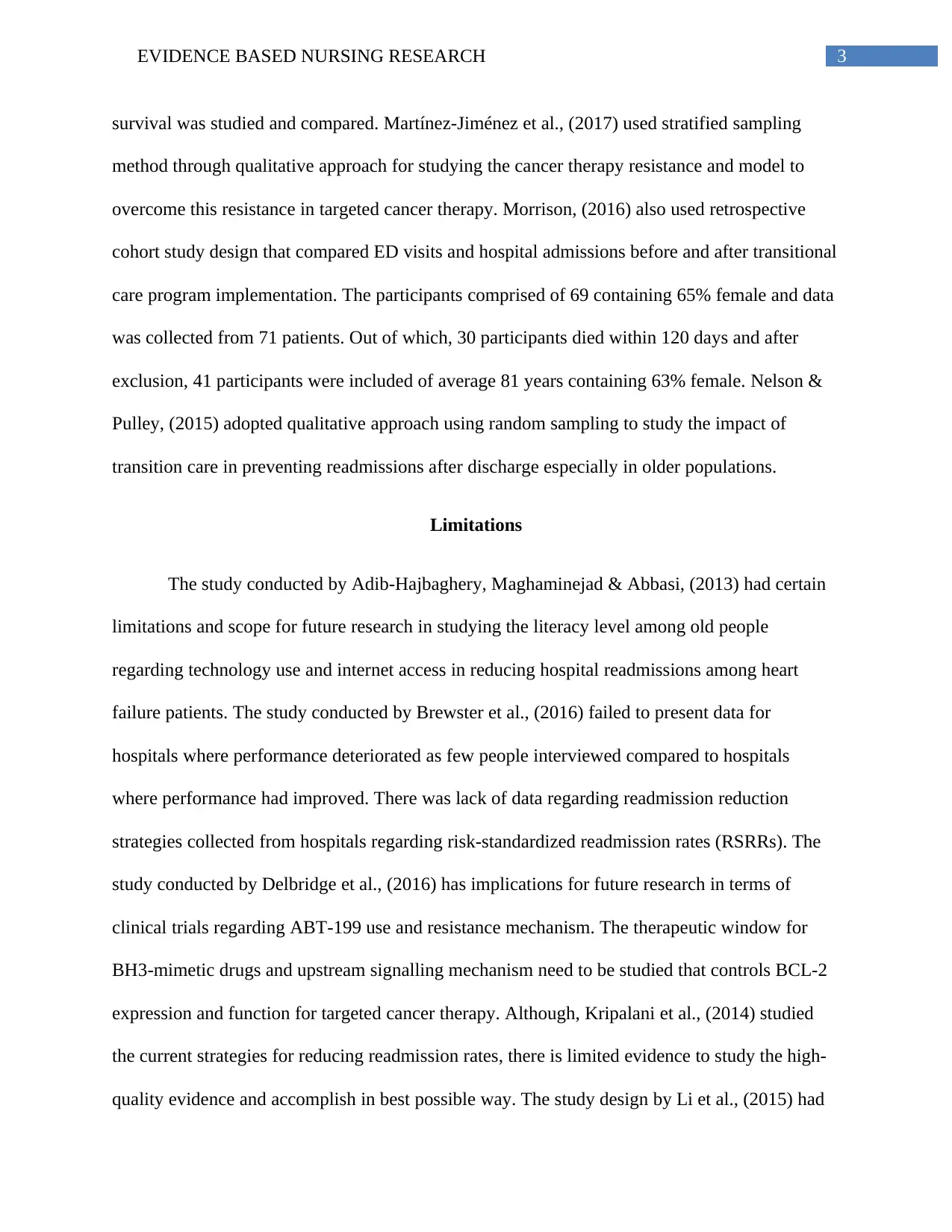
3EVIDENCE BASED NURSING RESEARCH
survival was studied and compared. Martínez-Jiménez et al., (2017) used stratified sampling
method through qualitative approach for studying the cancer therapy resistance and model to
overcome this resistance in targeted cancer therapy. Morrison, (2016) also used retrospective
cohort study design that compared ED visits and hospital admissions before and after transitional
care program implementation. The participants comprised of 69 containing 65% female and data
was collected from 71 patients. Out of which, 30 participants died within 120 days and after
exclusion, 41 participants were included of average 81 years containing 63% female. Nelson &
Pulley, (2015) adopted qualitative approach using random sampling to study the impact of
transition care in preventing readmissions after discharge especially in older populations.
Limitations
The study conducted by Adib-Hajbaghery, Maghaminejad & Abbasi, (2013) had certain
limitations and scope for future research in studying the literacy level among old people
regarding technology use and internet access in reducing hospital readmissions among heart
failure patients. The study conducted by Brewster et al., (2016) failed to present data for
hospitals where performance deteriorated as few people interviewed compared to hospitals
where performance had improved. There was lack of data regarding readmission reduction
strategies collected from hospitals regarding risk-standardized readmission rates (RSRRs). The
study conducted by Delbridge et al., (2016) has implications for future research in terms of
clinical trials regarding ABT-199 use and resistance mechanism. The therapeutic window for
BH3-mimetic drugs and upstream signalling mechanism need to be studied that controls BCL-2
expression and function for targeted cancer therapy. Although, Kripalani et al., (2014) studied
the current strategies for reducing readmission rates, there is limited evidence to study the high-
quality evidence and accomplish in best possible way. The study design by Li et al., (2015) had
survival was studied and compared. Martínez-Jiménez et al., (2017) used stratified sampling
method through qualitative approach for studying the cancer therapy resistance and model to
overcome this resistance in targeted cancer therapy. Morrison, (2016) also used retrospective
cohort study design that compared ED visits and hospital admissions before and after transitional
care program implementation. The participants comprised of 69 containing 65% female and data
was collected from 71 patients. Out of which, 30 participants died within 120 days and after
exclusion, 41 participants were included of average 81 years containing 63% female. Nelson &
Pulley, (2015) adopted qualitative approach using random sampling to study the impact of
transition care in preventing readmissions after discharge especially in older populations.
Limitations
The study conducted by Adib-Hajbaghery, Maghaminejad & Abbasi, (2013) had certain
limitations and scope for future research in studying the literacy level among old people
regarding technology use and internet access in reducing hospital readmissions among heart
failure patients. The study conducted by Brewster et al., (2016) failed to present data for
hospitals where performance deteriorated as few people interviewed compared to hospitals
where performance had improved. There was lack of data regarding readmission reduction
strategies collected from hospitals regarding risk-standardized readmission rates (RSRRs). The
study conducted by Delbridge et al., (2016) has implications for future research in terms of
clinical trials regarding ABT-199 use and resistance mechanism. The therapeutic window for
BH3-mimetic drugs and upstream signalling mechanism need to be studied that controls BCL-2
expression and function for targeted cancer therapy. Although, Kripalani et al., (2014) studied
the current strategies for reducing readmission rates, there is limited evidence to study the high-
quality evidence and accomplish in best possible way. The study design by Li et al., (2015) had
Paraphrase This Document
Need a fresh take? Get an instant paraphrase of this document with our AI Paraphraser
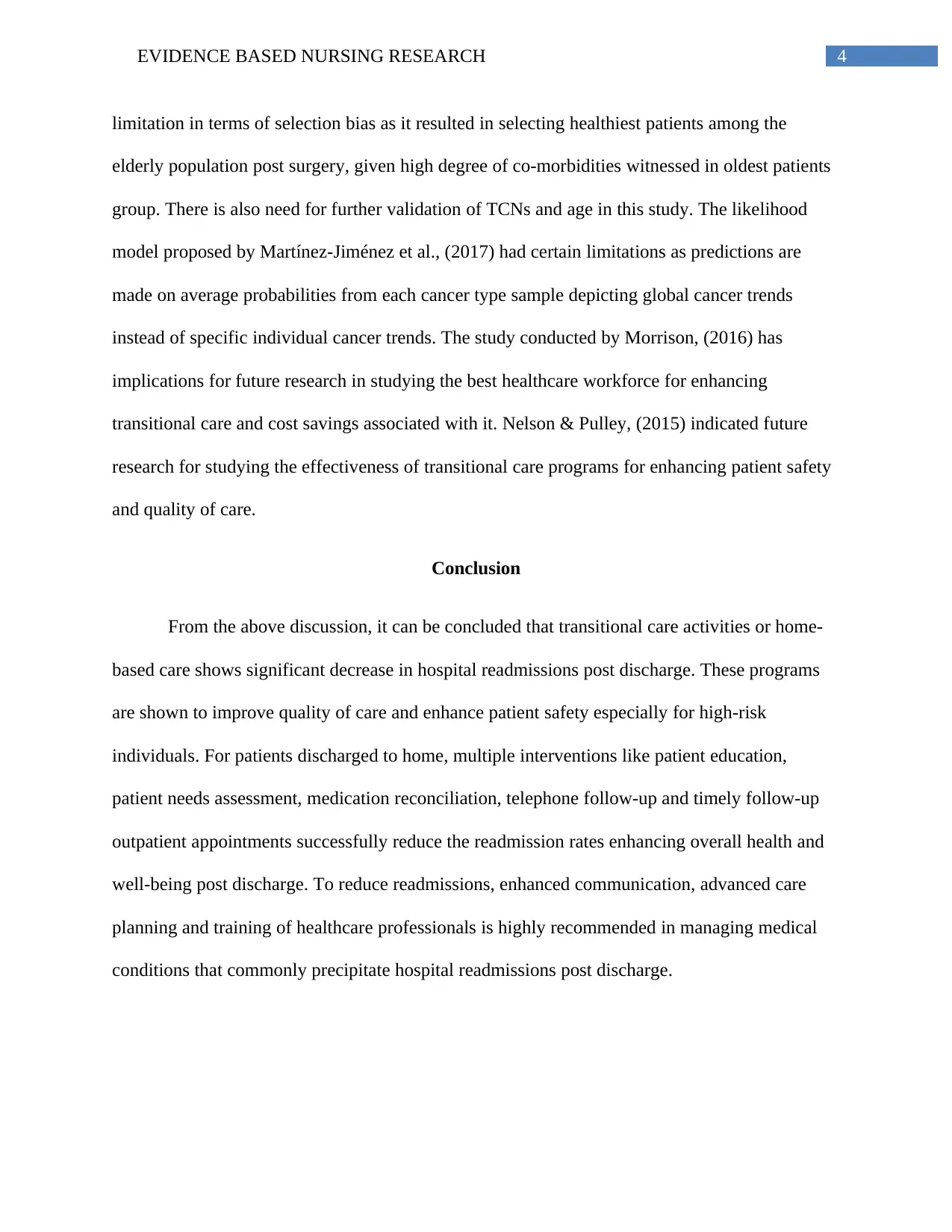
4EVIDENCE BASED NURSING RESEARCH
limitation in terms of selection bias as it resulted in selecting healthiest patients among the
elderly population post surgery, given high degree of co-morbidities witnessed in oldest patients
group. There is also need for further validation of TCNs and age in this study. The likelihood
model proposed by Martínez-Jiménez et al., (2017) had certain limitations as predictions are
made on average probabilities from each cancer type sample depicting global cancer trends
instead of specific individual cancer trends. The study conducted by Morrison, (2016) has
implications for future research in studying the best healthcare workforce for enhancing
transitional care and cost savings associated with it. Nelson & Pulley, (2015) indicated future
research for studying the effectiveness of transitional care programs for enhancing patient safety
and quality of care.
Conclusion
From the above discussion, it can be concluded that transitional care activities or home-
based care shows significant decrease in hospital readmissions post discharge. These programs
are shown to improve quality of care and enhance patient safety especially for high-risk
individuals. For patients discharged to home, multiple interventions like patient education,
patient needs assessment, medication reconciliation, telephone follow-up and timely follow-up
outpatient appointments successfully reduce the readmission rates enhancing overall health and
well-being post discharge. To reduce readmissions, enhanced communication, advanced care
planning and training of healthcare professionals is highly recommended in managing medical
conditions that commonly precipitate hospital readmissions post discharge.
limitation in terms of selection bias as it resulted in selecting healthiest patients among the
elderly population post surgery, given high degree of co-morbidities witnessed in oldest patients
group. There is also need for further validation of TCNs and age in this study. The likelihood
model proposed by Martínez-Jiménez et al., (2017) had certain limitations as predictions are
made on average probabilities from each cancer type sample depicting global cancer trends
instead of specific individual cancer trends. The study conducted by Morrison, (2016) has
implications for future research in studying the best healthcare workforce for enhancing
transitional care and cost savings associated with it. Nelson & Pulley, (2015) indicated future
research for studying the effectiveness of transitional care programs for enhancing patient safety
and quality of care.
Conclusion
From the above discussion, it can be concluded that transitional care activities or home-
based care shows significant decrease in hospital readmissions post discharge. These programs
are shown to improve quality of care and enhance patient safety especially for high-risk
individuals. For patients discharged to home, multiple interventions like patient education,
patient needs assessment, medication reconciliation, telephone follow-up and timely follow-up
outpatient appointments successfully reduce the readmission rates enhancing overall health and
well-being post discharge. To reduce readmissions, enhanced communication, advanced care
planning and training of healthcare professionals is highly recommended in managing medical
conditions that commonly precipitate hospital readmissions post discharge.
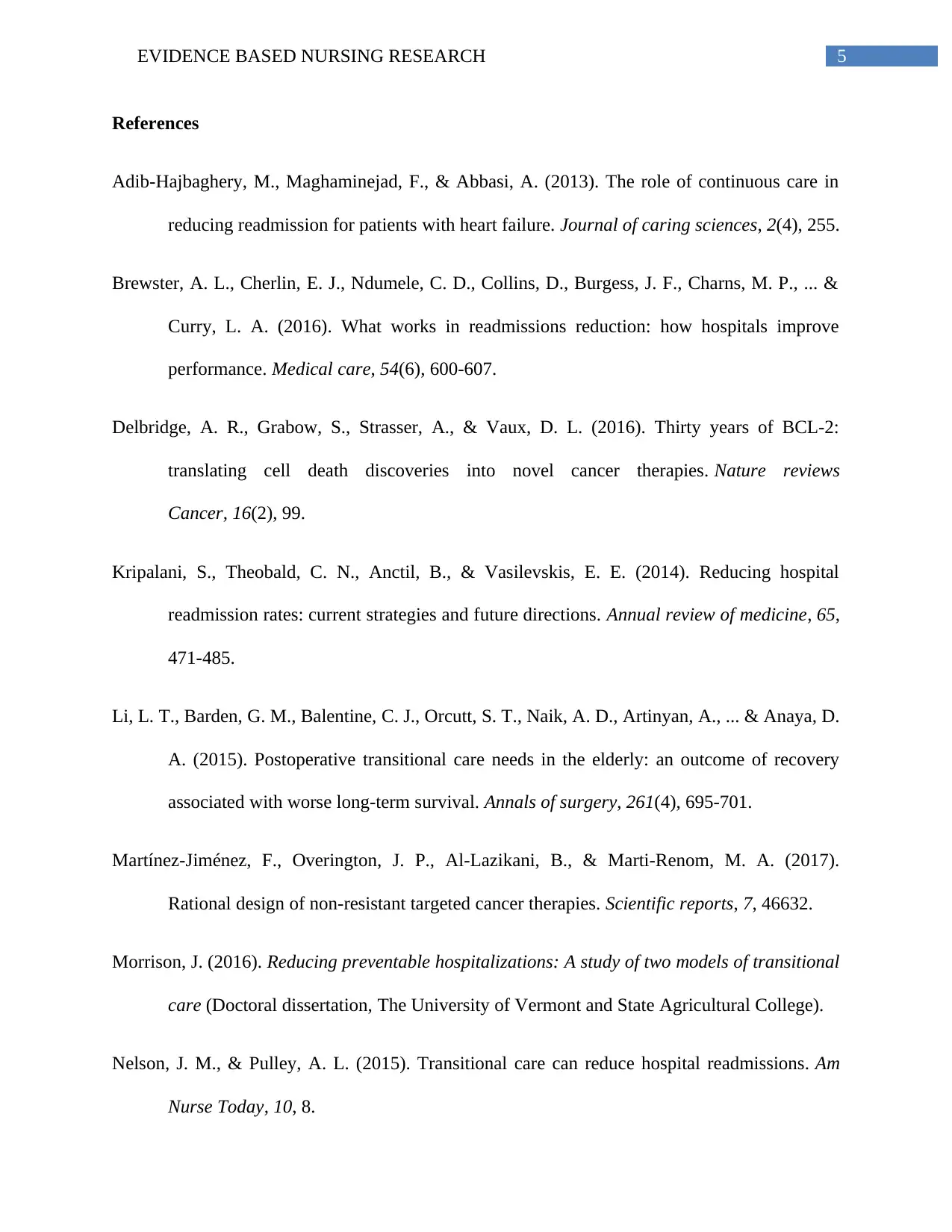
5EVIDENCE BASED NURSING RESEARCH
References
Adib-Hajbaghery, M., Maghaminejad, F., & Abbasi, A. (2013). The role of continuous care in
reducing readmission for patients with heart failure. Journal of caring sciences, 2(4), 255.
Brewster, A. L., Cherlin, E. J., Ndumele, C. D., Collins, D., Burgess, J. F., Charns, M. P., ... &
Curry, L. A. (2016). What works in readmissions reduction: how hospitals improve
performance. Medical care, 54(6), 600-607.
Delbridge, A. R., Grabow, S., Strasser, A., & Vaux, D. L. (2016). Thirty years of BCL-2:
translating cell death discoveries into novel cancer therapies. Nature reviews
Cancer, 16(2), 99.
Kripalani, S., Theobald, C. N., Anctil, B., & Vasilevskis, E. E. (2014). Reducing hospital
readmission rates: current strategies and future directions. Annual review of medicine, 65,
471-485.
Li, L. T., Barden, G. M., Balentine, C. J., Orcutt, S. T., Naik, A. D., Artinyan, A., ... & Anaya, D.
A. (2015). Postoperative transitional care needs in the elderly: an outcome of recovery
associated with worse long-term survival. Annals of surgery, 261(4), 695-701.
Martínez-Jiménez, F., Overington, J. P., Al-Lazikani, B., & Marti-Renom, M. A. (2017).
Rational design of non-resistant targeted cancer therapies. Scientific reports, 7, 46632.
Morrison, J. (2016). Reducing preventable hospitalizations: A study of two models of transitional
care (Doctoral dissertation, The University of Vermont and State Agricultural College).
Nelson, J. M., & Pulley, A. L. (2015). Transitional care can reduce hospital readmissions. Am
Nurse Today, 10, 8.
References
Adib-Hajbaghery, M., Maghaminejad, F., & Abbasi, A. (2013). The role of continuous care in
reducing readmission for patients with heart failure. Journal of caring sciences, 2(4), 255.
Brewster, A. L., Cherlin, E. J., Ndumele, C. D., Collins, D., Burgess, J. F., Charns, M. P., ... &
Curry, L. A. (2016). What works in readmissions reduction: how hospitals improve
performance. Medical care, 54(6), 600-607.
Delbridge, A. R., Grabow, S., Strasser, A., & Vaux, D. L. (2016). Thirty years of BCL-2:
translating cell death discoveries into novel cancer therapies. Nature reviews
Cancer, 16(2), 99.
Kripalani, S., Theobald, C. N., Anctil, B., & Vasilevskis, E. E. (2014). Reducing hospital
readmission rates: current strategies and future directions. Annual review of medicine, 65,
471-485.
Li, L. T., Barden, G. M., Balentine, C. J., Orcutt, S. T., Naik, A. D., Artinyan, A., ... & Anaya, D.
A. (2015). Postoperative transitional care needs in the elderly: an outcome of recovery
associated with worse long-term survival. Annals of surgery, 261(4), 695-701.
Martínez-Jiménez, F., Overington, J. P., Al-Lazikani, B., & Marti-Renom, M. A. (2017).
Rational design of non-resistant targeted cancer therapies. Scientific reports, 7, 46632.
Morrison, J. (2016). Reducing preventable hospitalizations: A study of two models of transitional
care (Doctoral dissertation, The University of Vermont and State Agricultural College).
Nelson, J. M., & Pulley, A. L. (2015). Transitional care can reduce hospital readmissions. Am
Nurse Today, 10, 8.
⊘ This is a preview!⊘
Do you want full access?
Subscribe today to unlock all pages.

Trusted by 1+ million students worldwide
1 out of 6
Related Documents
Your All-in-One AI-Powered Toolkit for Academic Success.
+13062052269
info@desklib.com
Available 24*7 on WhatsApp / Email
![[object Object]](/_next/static/media/star-bottom.7253800d.svg)
Unlock your academic potential
Copyright © 2020–2026 A2Z Services. All Rights Reserved. Developed and managed by ZUCOL.




